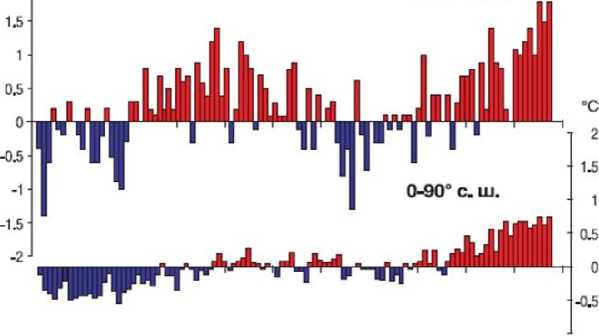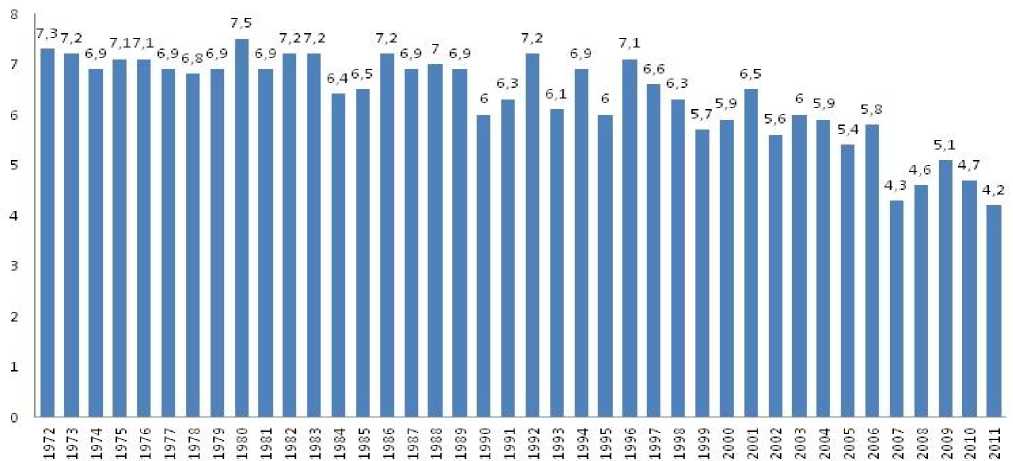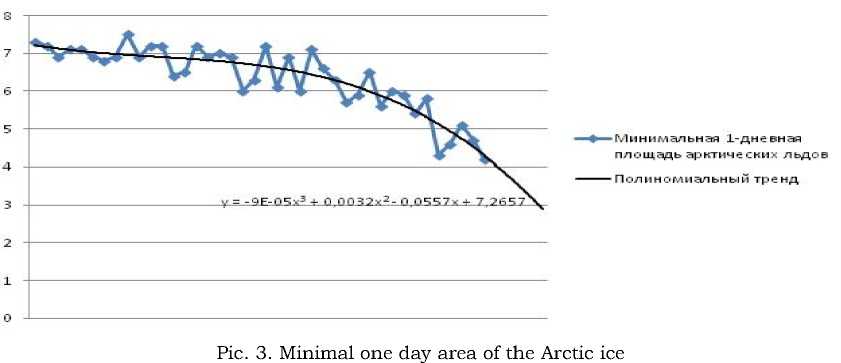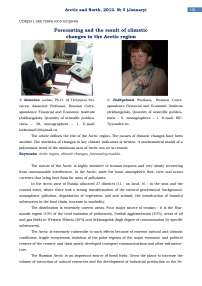Forecasting and the results of climatic changes in the Arctic region
Автор: Zelenina L.I., Fedkyshova S.I.
Журнал: Arctic and North @arctic-and-north
Рубрика: Ecology of the Arctic and the North, nature resources
Статья в выпуске: 5, 2012 года.
Бесплатный доступ
The article defines the role of the Arctic region. The causes of climatic changes have been studied. The statistics of changes in key climate indicators is written. A mathematical model of a polynomial trend of the minimum area of Arctic sea ice is created.
Arctic region, climatic changes, forecasting models
Короткий адрес: https://sciup.org/148320470
IDR: 148320470 | УДК: [551.588.7(985)+005.521](045)
Текст научной статьи Forecasting and the results of climatic changes in the Arctic region
The nature of the Arctic is highly sensitive to human impacts and very slowly recovering from unreasonable interference. In the Arctic, meet the basic atmospheric flow, river and ocean currents that bring here from far away of pollutants.
In the Arctic zone of Russia allocated 27 districts (11 - on land, 16 - in the seas and the coastal zone), where there was a strong transformation of the natural geochemical background, atmospheric pollution, degradation of vegetation, soil and subsoil, the introduction of harmful substances in the food chain, increase in morbidity.
The distribution is extremely uneven areas. Four major source of tension - it is the Murmansk region (10% of the total emission of pollutants), Norilsk agglomeration (30%), areas of oil and gas fields in Western Siberia (30%) and Arkhangelsk (high degree of contamination by specific substances).
The Arctic is extremely vulnerable to such effects because of extreme natural and climatic conditions, fragile ecosystems, isolation of the polar regions of the major economic and political centers of the country and their poorly developed transport communications and other infrastructure.
The Russian Arctic is an important source of fossil fuels. Given the plans to increase the volume of extraction of natural resources and the development of industrial production in the Po- lar Regions is important to consider the possibilities for adaptation to the Arctic region to climate change and for climate change mitigation by reducing greenhouse gas emissions.
According to the observations, the temperature in the Arctic over the past century has increased almost twice as fast as the average temperature of the Earth. Since the 1980's. Temperature in the cold season in most parts of the Arctic zone has increased by about 1 ° C per decade. The warming is most noticeable in winter. 2007 was the warmest for the region over the entire observation period from 1921. In 2008, the average anomaly temperature of air in the polar region was 1, 4 ° C.
According to Hydromet, the patterns of abnormal deviations of the average air temperature in the Arctic and the Northern Hemisphere in 1901-2007 year have such image:
Аномальные отклонения среднегодовой температуры воздуха в Арктике и в Северном полушарии в 1901-2007 2] -с 60-85° с. ш.

1900 1910 1920 1930 1 940 1950 1 960 1970 1980 1990 2000 2010
Pic. 1 Abnormal deviation means annual air temperature in the Arctic and in the Northern Hemisphere 1901-2007 years
Over the past hundred years the amount of precipitation in the Arctic has increased on average by about 8%. Most have increased precipitation in the form of rain with a maximum increase in autumn and winter. Approximately 10% of the area of snow cover has decreased over the past 30 years.
Significant reductions in the area of glaciers in the last 30 years (15-20%) confirm the instrumental monitoring Arctic ice from satellites. Satellite data show that an average of 2.7% over the decade reduced average area of ice in the Arctic. Especially noticeable dynamics of summer ice. Over the last decade the area of sea ice in September fell by 7.4%. Beginning in 2002, one by one all the more in-depth recorded lows of summer ice area, and in 2007 was made an absolute minimum for the period of satellite observation c 1979 - 4.3 million km 2 (Pic. 2).

Pic. 2. Histogram of the minimum area of Arctic sea ice (1972-2011 years)
It also decreases the average thickness of sea ice in the Arctic Basin. This is mainly due to reduction of the area occupied by perennial ice and, to a lesser extent, by reducing their thickness.
The melting of Arctic sea ice leads to increased warming in the region due to the so-called positive feedback: an increase in the rate of reduction of ice cover reduces the reflectivity of the surface (the dark ocean absorbs more heat than white ice) and, consequently, an increase in incoming solar radiation.
Statistical analysis of data allowed constructing a polynomial trend, determining a sufficient degree of probability forecast values for the minimum area of Arctic ice, for example, by 2016. The results: less than 3 million km 2 (Pic. 3).

Estimates of future changes in ice cover in the Arctic Ocean talking about accelerating the reduction of its size and weight. Calculations show that, during the XXI century the maximum area of sea ice (March) will be reduced by 2% per decade, and the minimum area of ice (September) - 7% per decade over the area of ice at the end of the XX century. At this rate of reduction of the ice is already in the next decade we can expect them to retreat by the end of summer to the
Arctic polar region, and after 30 years in the summertime Arctic could completely freed from the ice.
The changes of climate can lead to irreversible results the eco system of the Arctic:
-
a) The reduction of biodiversity;
-
b) exacerbation of existing problems of competition;
-
c) the growing influence of ultraviolet radiation on biological processes in the marine environment ;
-
d) reduction in the habitat of polar bears, seals, several species of birds;
-
e) violation of the forage base and traditional migration routes of reindeer and other ani
mals.
For the environment :
-
1) it will continue to increase in average surface air temperature. The most notable increase in temperature will be in the winter. It should be borne in mind the rather high level of uncertainty in the estimates, due to insufficiently dense network of observations, the relatively short series of multi-instrumental meteorological observations (regular observations in the Arctic began in the second half of the twentieth century) and the limitations of spatial resolution of climate models. More research is needed to climate change in selected regions of the Russian Arctic;
-
2) it is expected to reduce the period of stable snow cover, more precipitation (especially winter), river flow and temperature rise of water in the reservoirs;
-
3) by the middle-century could be reduced during icy conditions, increase the rate of degradation of the permafrost. Reduced Arctic sea ice will be mainly due to reduction in size and thickness of the multi-year ice;
-
4) The projected sea-level rise and increased frequency and intensity of hazardous-weather events;
-
5) increase in the concentration of pollutants in the atmosphere;
-
6) increase in water pollution, land and sea;
-
7) the increase in methane emissions from thawing permafrost.
Predicted economic losses are as follows:
-
1) an increase in height of wind waves and the appearance of degraded fragments of icebergs in the Arctic ice islands, which may pose a risk to production facilities and vehicles;
-
2) due to sudden changes in temperature and increasing severe weather events may increase the load on the energy infrastructure, growth in the number of accidents;
-
3) reducing capacity and the period for delivery in remote areas on winter road routes, laid on frozen beds, due to changes in the timing and processes of freezing and opening of rivers and reservoirs;
-
4) there is a possibility of formation of complex ice conditions (frequency of 10-20%) in the Straits Vilkitski, Shokalski, Dmitry Laptev, Sannikov and Long limiting bezledokolnoe sailing the Northern Sea Route;
-
5) a violation of transportation due to the increased frequency and intensity of the anomalous weather events;
-
6) because of the ground motions in the zones of melting permafrost could increase risks to buildings and facilities, transportation systems, including pipelines;
-
7) violation of the infrastructure of coastal areas due to increased storm activity, coastal erosion and rising sea levels.
Список литературы Forecasting and the results of climatic changes in the Arctic region
- The Arctic on the eve of the third millennium: the resource potential and environmental issues / ed. Gramberg JS, Laverov NP - St. Petersburg: Nauka, 2000.
- Beketov, NV Greening of investment policy in the Arctic / / Problems of the modern economy. - 2002. - № 1 (5).
- The impact of climate change on the Russian Arctic: analysis and solutions to problems. WWF-Russia. M., 2008.
- Report on the peculiarities of climate in Russia. - M: Roshydromet, 2008.
- Istomin, A., K. Pavlov, Celine B. Economy of the Arctic zone of Russia / / Society and Economy. - 2008− № 7. − p. 158−172.
- Leonov Yu Arctic Investigations are continuing / / Science in Russia. − 2008. − № 3. − С. 104−112.


